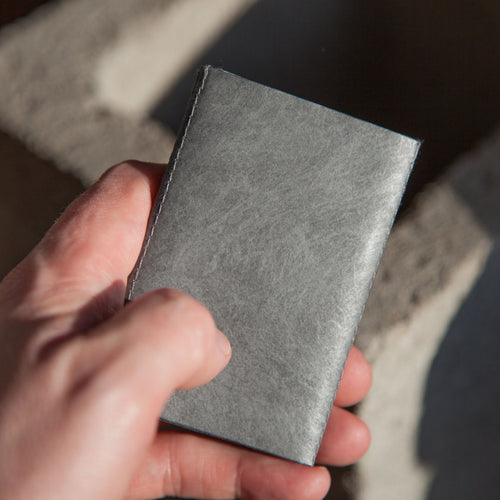Did you hear about the Minimalist Coin Wallet we launched at the end of last year on Kickstarter? Well, we’ve been hard at work getting these produced and I just wanted to provide a bit of a behind the scenes look and status update…
How do you ship 60 inch rolls of fabric to Japan?
The first challenge was transporting material. As of now, I’m pleased to say that all of the materials have been shipped to produce ALL of the tiers of wallets (over 3,000) and production has started.
Most products are made from materials that are sourced from the production country. The manufacturer just specifies something like “Black Ripstop Nylon” and, if the product is being made in China, a material within the country is identified. But in our case, we don’t treat materials as commodities. Rather, they make a key difference in the performance of our products.
From fibers, to coatings, to processes… everything about our materials is either custom or chosen for a very specific reason. They’re far from commodities and often very difficult to obtain. As it turns out, our supply chain process is essentially to gather everything necessary for production in my California studio and then air ship it to the factory in Japan. This may be the least efficient way to make something possible! But we are optimizing for control and quality, so this is the only way to achieve that, especially with the time constraint of the Kickstarter.
Communication
You may be wondering… how do we communicate with a factory so far away? First of all, the product itself is the cornerstone of all of the activity. When we first started, I made samples, patterns, and specifications to describe what we were trying to make. The factory further refined the patterns in order to make the product even better. Whenever I receive a sample they created, no words are necessary since I can see exactly what they did.
For notes, photos with arrows to highlight things are the most useful. This is the case when working with any factory, whether in the US or abroad.
The last piece of the puzzle is the actual language. Since my wife is Japanese, she translates outbound communication. For inbound messages, Google Translate is pretty amazing and it’s definitely been one of the most used apps on my phone in recent months!
Shipping logistics
 Another key element of the process of delivering the rewards is packing and shipping. This is the first Kickstarter project we’ve done since having our studio and it’s provided us some additional flexibility. The first milestone of the project was to deliver the Slim Packs to domestic backers before Christmas. We would normally ship all of the backpacks to our fulfillment house near LA and have them ship everything at once. Just to be sure we’d hit the deadline, we went ahead and packed and shipped them all directly. Having a bit of space to spread out made things pretty efficient and we were able to hit our first milestone on time.
Another key element of the process of delivering the rewards is packing and shipping. This is the first Kickstarter project we’ve done since having our studio and it’s provided us some additional flexibility. The first milestone of the project was to deliver the Slim Packs to domestic backers before Christmas. We would normally ship all of the backpacks to our fulfillment house near LA and have them ship everything at once. Just to be sure we’d hit the deadline, we went ahead and packed and shipped them all directly. Having a bit of space to spread out made things pretty efficient and we were able to hit our first milestone on time.
What’s next?
I’ve approved the final Coin Wallet sample and the factory has begun cutting the material. We’ve requested that an initial batch be sent to us during the production run for an additional quality check. In apparel, this practice is known as inspecting “tops” in which a few of the pieces is picked from the top of the pile during the first run. In our case, we’re sort of inspecting “tops” by air shipping them to us.
Want to follow along real-time?
 Curious what 30,000 magnets look like? Want to get some sneak peeks as we develop the packaging? Follow along on instagram where we’re sharing more tidbits as they unfold.
Curious what 30,000 magnets look like? Want to get some sneak peeks as we develop the packaging? Follow along on instagram where we’re sharing more tidbits as they unfold.
Interested in Pre-ordering the Coin Wallet?
We’re accepting pre-orders for the Coin Wallet on our site while production is taking place. You can also pre-order a Slim Pack here.
Thanks again to all the Kickstarter backers for supporting this project and I’m looking forward to getting them in your hands!






0 Comments